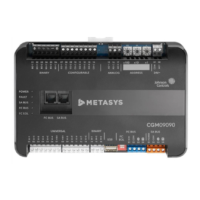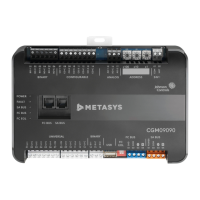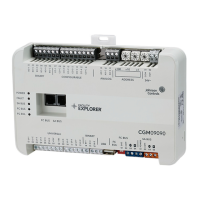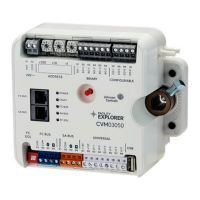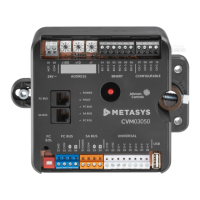Refer to the MS/TP Communications Bus Technical
Bulletin (LIT-12011034) for more information
about controller device addresses and how to
set them on MS/TP buses.
Removing a terminal block
About this task:
To remove a terminal block from the circuit board,
complete the following steps:
Note: You need a flat blade screwdriver to remove
the terminal block.
1. To prevent any possibility of damage from an
accidental short, remove power from the
controller.
2. Underneath the terminal block, in the small gap
between the bottom of the terminal block and
the circuit board, insert the flat blade of the
screwdriver.
Figure 11: Terminal block
3. To detach the left-hand side of the terminal block,
position the flat blade underneath the terminal
block to the left, and push down the screwdriver
handle. When you do this, you are using the
screwdriver as a lever to pry up the terminal block.
4. To detach the right-hand side of the terminal block,
position the flat blade underneath the terminal
block to the right, and push down the screwdriver
handle.
5. If necessary, repeat steps 3 and 4 until the terminal
block is removed.
Removing the controller cover
About this task:
Important: Electrostatic discharge can damage
controller components. Use proper electrostatic
discharge precautions during installation, setup, and
servicing to avoid damaging the controller.
Important: Disconnect all power sources to the
controller before removing the cover and changing
the position of any jumper or the EOL switch on
the controller. Failure to disconnect power before
changing a jumper or EOL switch position can result
in damage to the controller and void any warranties.
The controller cover is held in place by four plastic
latches that extend from the base and snap into
slots on the inside of the housing cover.
To remove the controller cover, complete the
following steps:
1. Place your fingertips under the two cover lift tabs
(Physical features) on the sides of the housing
cover and gently pry the top of the cover away
from the base to release the cover from the two
upper latches.
2. Pivot the top of the cover further to release it from
the lower two latches.
3. Replace the cover by placing it squarely over the
base, and then gently and evenly push the cover
on to the latches until they snap into the latched
position.
Figure 12: CGM with cover removed showing EOL switch
and jumper positions (CGM09090 model shown)
Setting the End-of-Line (EOL) switch
About this task:
Each CGM controller has an EOL switch, which, when set
to ON (up), sets the controller as a terminating device on
the bus. See Figure 12 for the EOL switch location. The
default EOL switch position is OFF (down).
Figure 13: End-of-Line switch positions
To set the EOL switch on a controller, complete the
following steps:
1. Determine the physical location of the controller on
the FC bus.
2. Determine if the controller must be set as a
terminating device on the bus.
Note: For detailed information about EOL
termination rules and EOL switch settings on FC
buses, refer to the MS/TP Communications Bus
Technical Bulletin (LIT-12011034).
M4-CGM General Purpose Application Controller Installation Guide 17
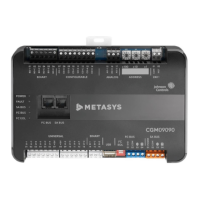
